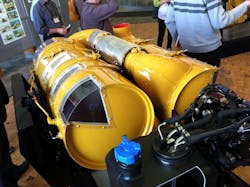Caterpillar announced its Tier 4-Final solution in Peoria this week and then introduced a new line of hybrid excavators. Instead of an electric hybrid technology like that used by Komatsu, Caterpillar chose an hydraulic energy storage and reuse system.
Caterpillar will use an SCR component to reach the Final requirements on NOx reduction. In an announcement the same day, Bobcat said it will use parent Doosan’s engines to reach Final with no DPF, although no specifics were provided.
In my last blog, I listed some of the concerns equipment managers have mentioned in our LinkedIn group about Tier-4 Final, and then I asked for any additional concerns. Armed with that, I traveled to Peoria to see what Caterpillar had to say.
1) The SCR component nestles neatly behind the existing DOC/DPF module it uses to meet Tier 4-Interim, which means no new changes will need to be made in machine design. Remember, though, that Caterpillar has redesigned nearly 300 machines to accommodate its Interim solution, which meant equipment prices increased. Don’t expect prices to drop for Final machines. For those who plan on skipping the Interim version, you’ll still see higher acquisition costs when you purchase the Final machines. That will be across brands.
1) Caterpillar will release a retrofit kit that will enable its engines to use available fuel, which appears to address the problem of machinery used in areas without ultra low sulfur diesel (USLD). Company officials declined to give a timetable on when those kits would be available.
2) Caterpillar spent a fair amount of time stressing that it has spent the past couple of years training its dealer technicians, preparing them to care for the Tier 4 technologies. As would be expected, officials expressed extreme confidence that their field personnel were ready and able.
3) Some equipment managers suggest the rate of change in environmental requirements will render obsolete our concerns about Tier 4, and Caterpillar seems to agree. Tana Utley, chief technology officer (although she was just named to head up Cat’s UK engine operations) told us Caterpillar is spending $8 million a day on research & development, some of which is spent on visualizing future fuel scenarios.
Lou Balmer-Millar, director of research and advanced engineering, said future machines will have to operate on a variety of fuels, including renewable diesel, fuel from waste, gas to liquids, poor-quality fuels. It’s safe to say the retrofit kits is one result of that. Balmer-Millar also said the partnership with natural-gas engine expert Westport should yield engines with “diesel-like performance,” as well as dual-fuel engines and retrofit kits.
The message I take from Peoria is that engine manufacturers and machine OEMs know their customers worry about technology and maintenance. Although one Caterpillar product manager agreed with me that the majority of end-users are thinking a year or two ahead instead of the 10 years we’re discussing here, he’s confident that as machines reach the end of their first useful life, most of the concerns about Tier 4 will have been addressed.






